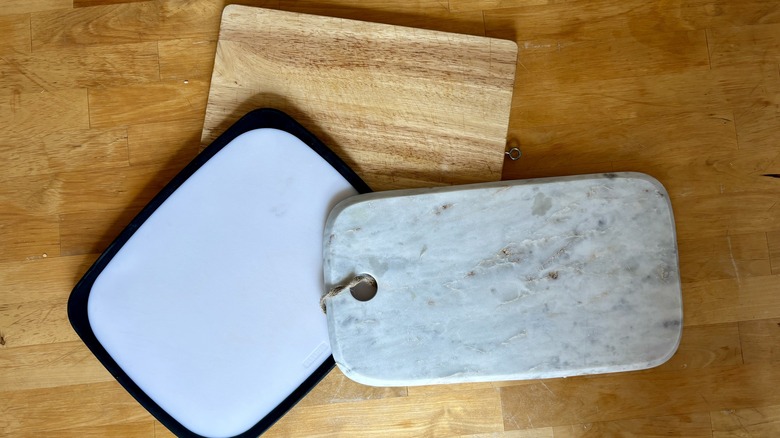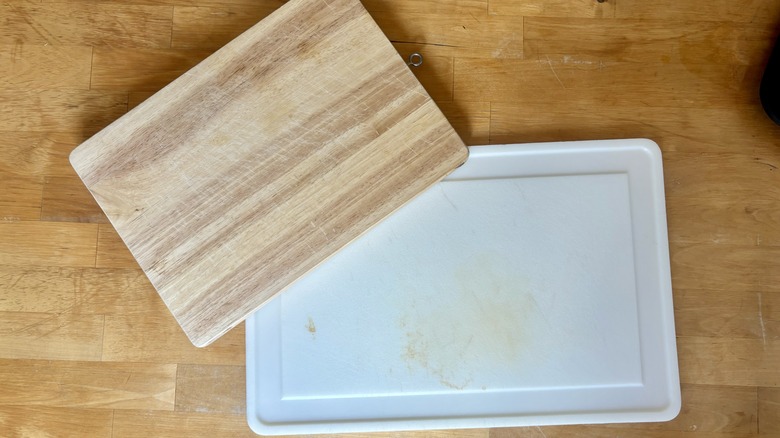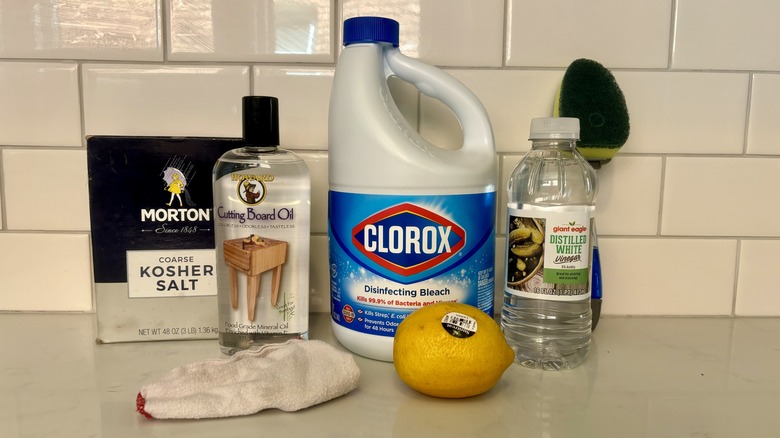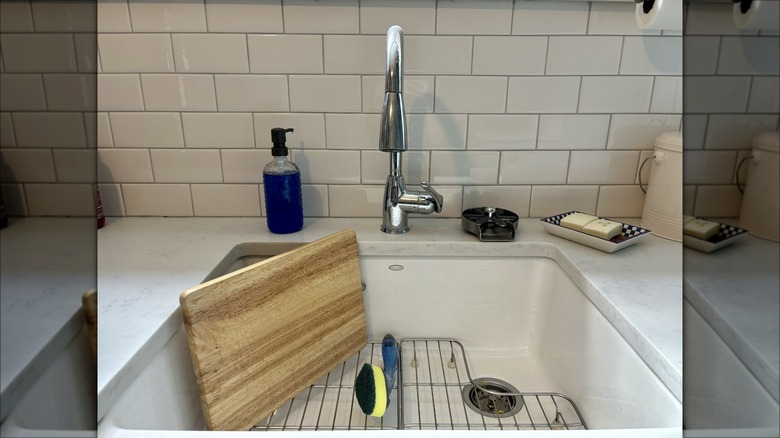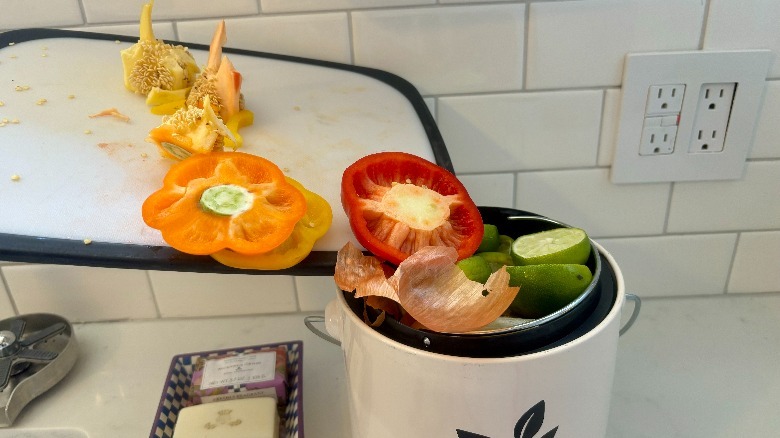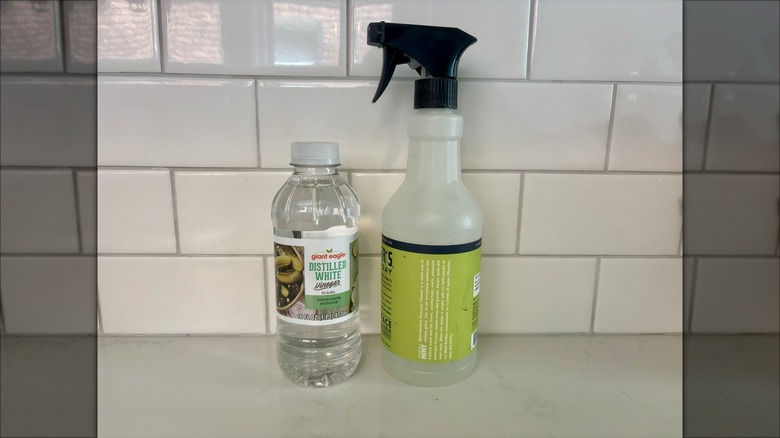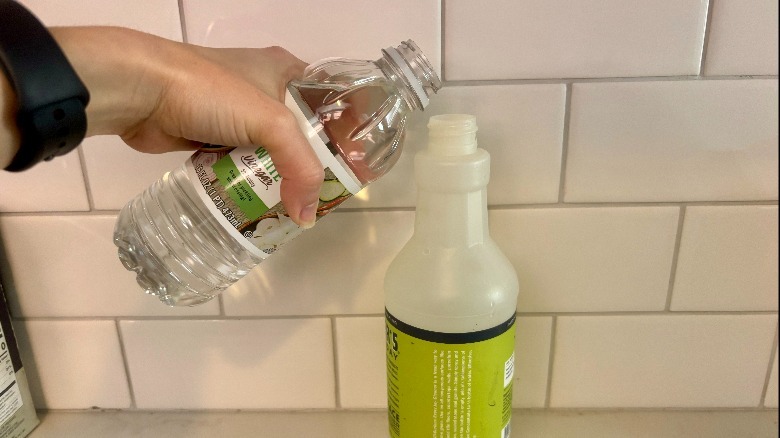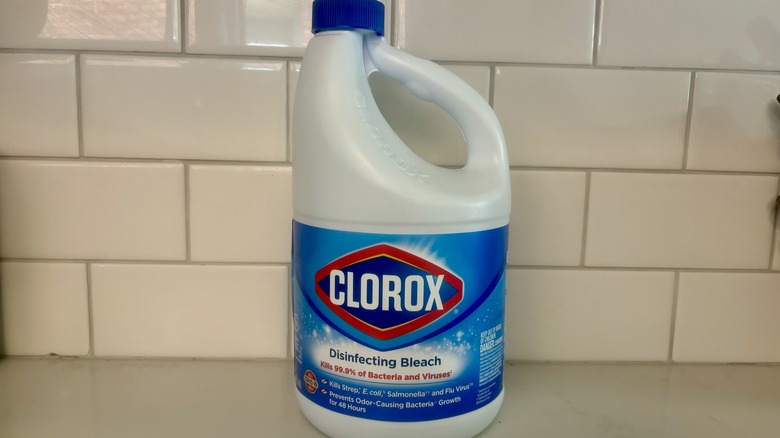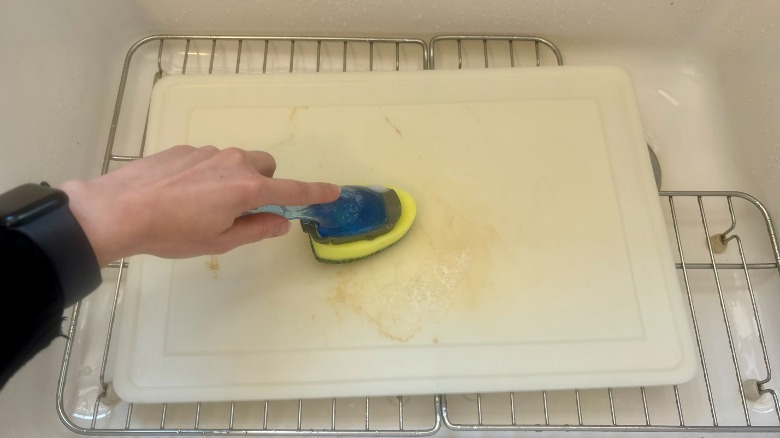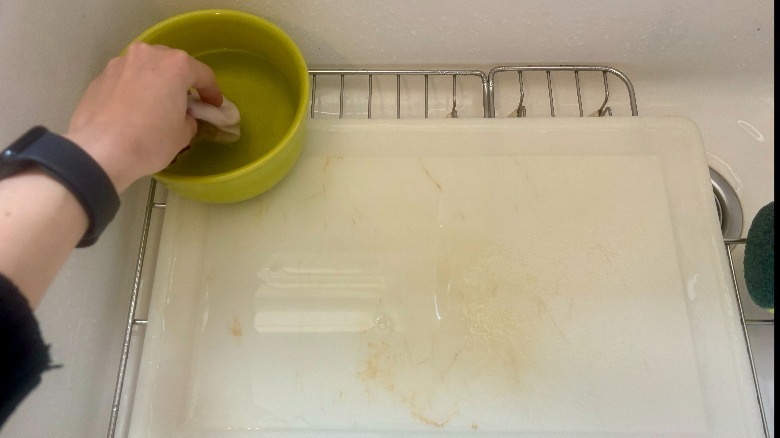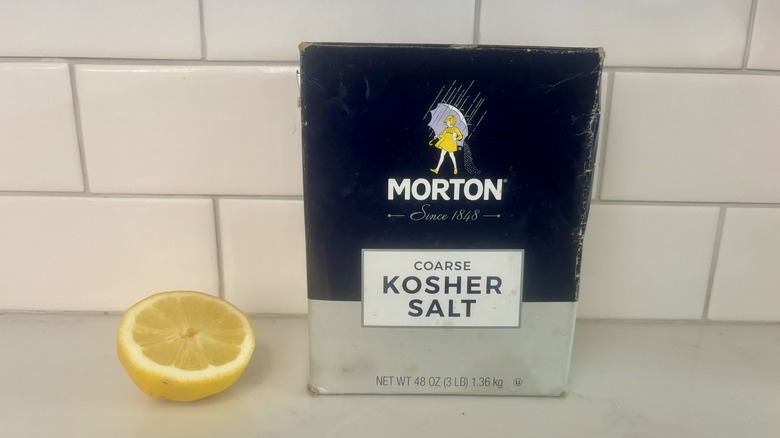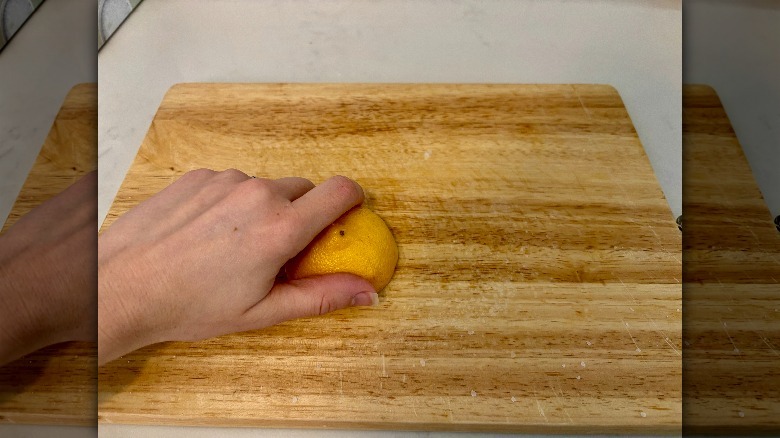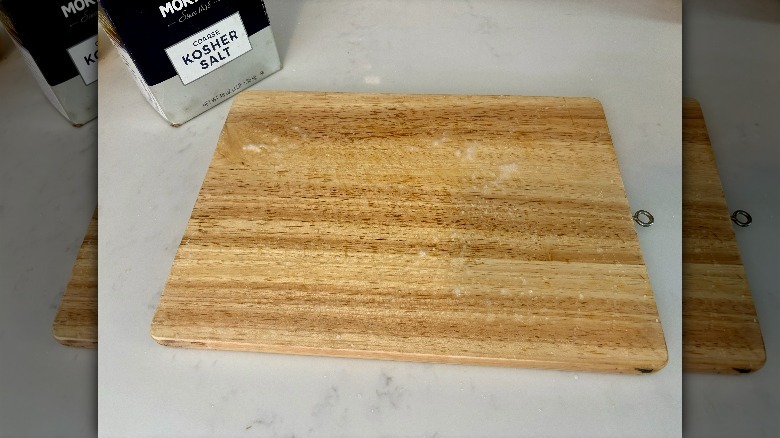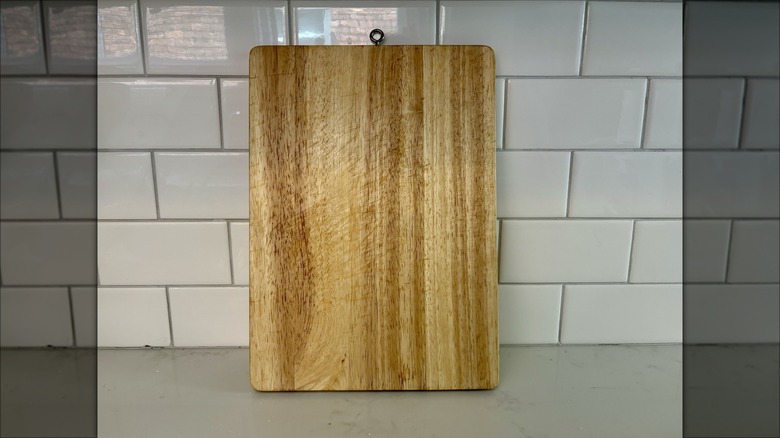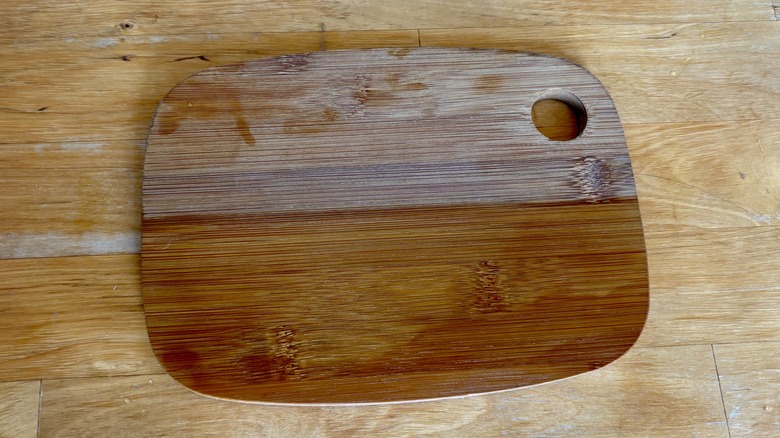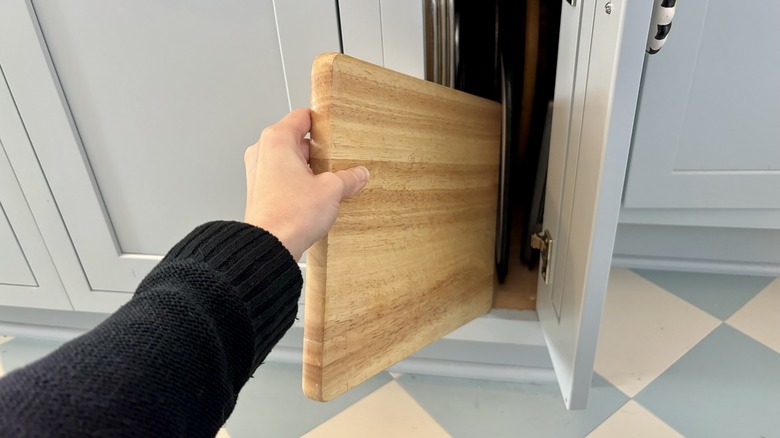How To Properly Sanitize And Clean Any Type Of Cutting Board
Cutting boards are among the most commonly used kitchen tools. They are used for prepping and chopping almost anything, from fruits and vegetables to meats and cheese. It is easy to think that these flat, unadorned boards just require a quick rinse, but the truth is that if you do not clean your cutting boards properly, you are potentially exposing yourself to harmful bacteria.
There are multiple kinds of cutting boards, each of which requires specific care. For example, marble and glass are considered non-porous materials, which means liquid can not penetrate them. While this prevents bacteria from seeping in it can cause knives to dull quickly. Wooden cutting boards, while better for your knives, are porous and will develop deep grooves from cutting, which can harbor bacteria. Plastic is non-porous but is still susceptible to those same cuts and grooves. This can become particularly hazardous when cleaning up after cutting meat such as chicken. Improperly cleaned cutting boards can even retain lingering smells. We will show you the best and safest ways to clean your cutting boards to keep your kitchen healthy.
How long cutting boards last
Before we get too far in, it is essential to remember that most cutting boards are not lifetime purchases. Plastic cutting boards, for example, last about five years if used regularly. Wood cutting boards can last up to 10 years, depending on their quality and thickness. An exceptionally crafted wooden cutting board may last longer but will require more maintenance, such as sanding.
If you notice your cutting board forming deep cracks or scratches, it is likely time to consider replacing it. Additionally, if your board has warped out of shape and will no longer sit flat, it is time to replace it, as this can be a safety hazard when cutting. Wooden boards are more prone to warping than other kinds due to their porous nature.
Tools you will need
If your cutting board still has life left in it but just needs a little love, the good news is you don't need a lot to revive it. Depending on your method, you will need a combination of a sponge, dish soap, vinegar, bleach, lemon, and salt. We recommend using unscented dish soap for cutting boards. You may also need mineral oil for wooden cutting boards, a dry cloth, or a dishwasher. Most of these items can be easily found in a home or a grocery store.
It is vitally important to remember never to mix bleach and vinegar. When deciding which method to use, pick one or the other, but never both. Bleach and vinegar mix create poisonous chlorine gas, which can cause permanent lung damage and death.
Using the dishwasher
This is the simplest method. The advantage of using a dishwasher is that it is one step, and the high heat of the dishwasher kills bacteria and sterilizes better than the hot water from a faucet. The downside is that this method can only be used on dishwasher-safe materials, such as plastic and tempered glass cutting boards. Wooden cutting boards should never be placed in the dishwasher.
The process is easy. Take your dirty cutting board and remove all large scraps. Place it directly into the dishwasher with the other dishes. Then run your dishes in your preferred way.
By hand with soap and water
Washing a cutting board by hand is the gentlest way to clean it and can be used on all cutting boards. This is also the first step to completing other methods, such as sanitizing with bleach.
First, wipe all large chunks off the cutting board. You can do this by hand or with a towel.
Next, rinse your cutting board under hot water. Use a sponge dipped in dish soap to scrub all the surfaces of the board, making sure to wash the front, back, and sides.
Finally, rinse all soap off, ensuring that all residue has been removed. Then, pat dry with a towel. Do not leave boards soaking wet. Prop it upright and allow the cutting board to dry.
Using a vinegar solution
If your cutting board cleaning needs an additional boost, vinegar is an effective cleaner with additional disinfecting properties and a powerful deodorizer. Vinegar can help remove harsh smells and residue left on cutting boards. However, it should not be used on natural stones such as marble, as it is highly acidic and can cause etching.
Wipe off all debris from the cutting board. Fill a spray bottle with one cup of water and one-quarter cup of vinegar.
Spray the cutting board's surface using the vinegar mixture. Wipe down the board using a washcloth, paying particular attention to any smelly or stained areas. Rinse the cutting board and pat dry. Prop up to dry.
Sanitizing using bleach
Nothing compares to bleach's sanitizing quality. The United States Department of Agriculture recommends washing cutting boards with bleach as the best way to kill harmful bacteria. This method may be used on all cutting boards.
Remove debris from the cutting board, and wash by hand with soap and water.
Dilute bleach by mixing one gallon of water with one tablespoon of bleach, such as regular unscented Clorox. Do not use products labeled "cleaner" in a spray bottle. You want to use regular, concentrated bleach for this. The mixture can be placed in a smaller bowl or spray bottle to make application easier.
Non-wooden cutting boards can be dipped directly in a tray filled with bleach water. Wooden cutting boards should have a bleach mixture liberally applied with a spray bottle or sponge. Allow the bleach to sit on the cutting board for at least two minutes.
You do not need to rinse the bleach off when done. Simply allow it to dry, as the active ingredient of bleach, sodium hypochlorite, slowly breaks down into sodium chloride (salt) and oxygen. If you are concerned, though, you can still rinse off the bleach before drying.
Using a lemon and salt
Lemons are a great tool for cleaning. If your cutting board smells and has shallow cuts, half a lemon, and salt are excellent ways to bring new life without having to resurface it. Once again, lemons, like vinegar, are acidic and should not be used on natural stones such as marble, as they will damage the surface.
Place the board on a flat, stable surface, such as the bottom of the sink or on a countertop. Then, while the cutting board is still damp, sprinkle it with coarse salt. The dampness will help the salt stick initially.
Cut a lemon in half. Place the lemon cut side down on the cutting board. Rub the lemon over the cutting board and salt, using small circular motions to exfoliate the board's surface gently. This will help you get into light cracks and fill them out, while the lemon juice will deodorize.
If the board is particularly smelly, allow the lemon and salt mixture to sit on it for a few minutes, then rinse the board again. Pat dry and place upright to dry.
Drying the cutting boards
We instruct you to use a two-step drying system: pat the cutting board dry, then prop it upright to air dry. This allows the cutting board to dry quickly and evenly and prevent warping.
This is particularly important for wooden cutting boards, which are sensitive to water and warping. If you do not prop the board upright, the bottom can retain moisture, which will prevent it from drying and can damage the board in the long run.
Oiling wooden cutting boards
If you have a wooden cutting board, one final step should be taken after deep cleaning it: oiling. Using a food-grade mineral oil on the wood will keep the wood supple and increase longevity. You do not need to apply it after every use, but it is a good idea after a deep clean or when you notice the wood looking pale and dry.
To apply oil, simply pour food-grade mineral oil directly onto the cutting board, and using a soft cloth, rub it in an even coat along all surfaces. Use a dry, clean cloth to rub off any remaining oil and remove any remaining dampness.
The best way to store cutting boards
The best way to store your cutting board is upright, especially for wooden cutting boards. Wood is so porous that it takes longer to dry and is prone to retaining water. Storing flat can prevent the water from escaping and cause the boards to warp.
Some cutting boards even come with a hook or handle to hang and display on a wall. This is an excellent option if the cabinet space is limited, but you still want to store your cutting boards in the most protective way possible.
